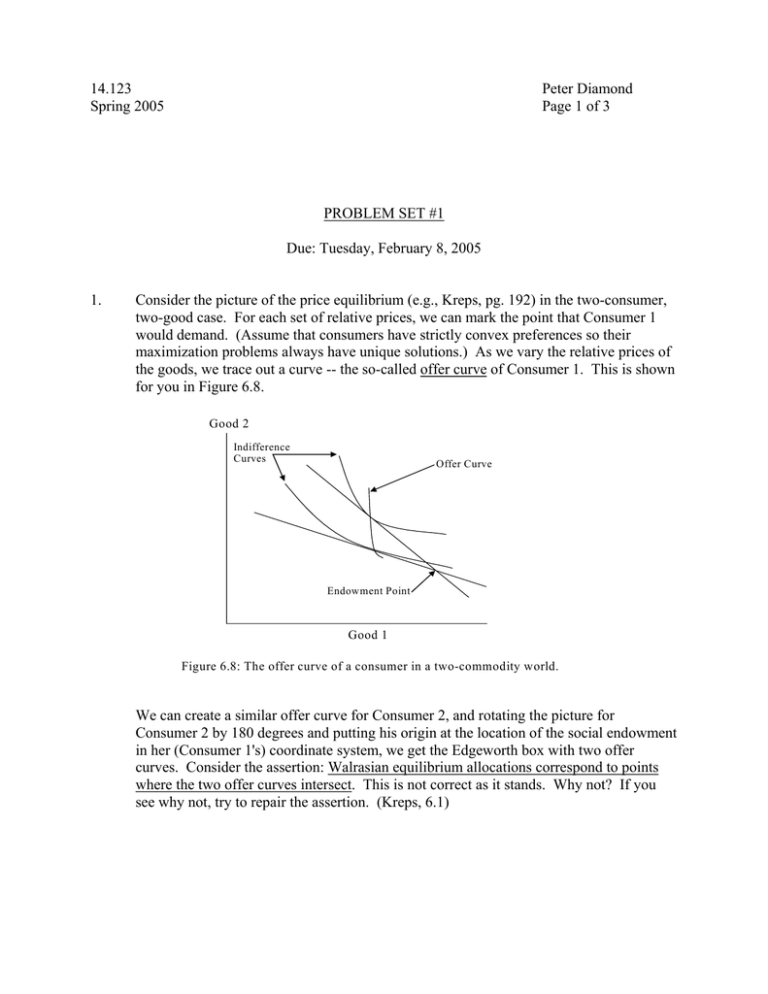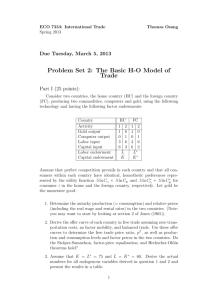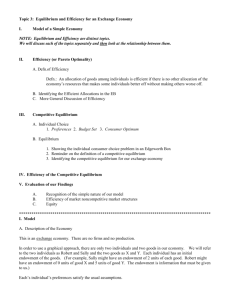14.123 Peter Diamond Spring 2005 Page 1 of 3
advertisement

14.123 Spring 2005 Peter Diamond Page 1 of 3 PROBLEM SET #1 Due: Tuesday, February 8, 2005 1. Consider the picture of the price equilibrium (e.g., Kreps, pg. 192) in the two-consumer, two-good case. For each set of relative prices, we can mark the point that Consumer 1 would demand. (Assume that consumers have strictly convex preferences so their maximization problems always have unique solutions.) As we vary the relative prices of the goods, we trace out a curve -- the so-called offer curve of Consumer 1. This is shown for you in Figure 6.8. Good 2 Indifference Curves Offer Curve Endowment Point Good 1 Figure 6.8: The offer curve of a consumer in a two-commodity world. We can create a similar offer curve for Consumer 2, and rotating the picture for Consumer 2 by 180 degrees and putting his origin at the location of the social endowment in her (Consumer 1's) coordinate system, we get the Edgeworth box with two offer curves. Consider the assertion: Walrasian equilibrium allocations correspond to points where the two offer curves intersect. This is not correct as it stands. Why not? If you see why not, try to repair the assertion. (Kreps, 6.1) 14.123 Spring 2005 2. 3. Peter Diamond Page 2 of 3 Consider the following exchange economy. There are two goods and two consumers. The two goods are called tillip and quillip and the two consumers are called 1 and 2. Consumer 1 has utility function U1 ( t , q ) = .4 ln( t ) + .6 ln(q ) (where t is the amount of tillip 1 consumes, and q is the amount of quillip). Consumer 2 has utility function U 2 ( t , q ) = .5 ln( t ) + .5 ln(q ). Consumer 1 is endowed with 10 units each of quillip and tillip. Consumer 2 is endowed with 10 units of quillip and 5 units of tillip. (a) What is the Walrasian equilibrium of this economy? (If there is more than one equilibrium, give them all.) (b) Suppose a social dictator wished to implement an allocation that makes U1 ( t , q ) + U 2 ( t , q ) as large as possible at the equilibrium. Give all the possible reallocations of the endowment that give the dictator's optimal endowment as a Walrasian equilibrium. (Kreps, 6.2) A particular social planner I know is very big on mellow consumers. Specifically, she hopes to prevent her consumers from envying each other. To this end, she defines an envy-free allocation of resources as one in which no consumer would rather have the consumption bundle assigned to another consumer instead of his or her own. Our social planner wishes to implement an envy-free allocation. She also wishes the allocation to be efficient. This social planner is also lazy. She isn't willing to figure out the utility functions of her consumers. (She does have a good list of all their endowments.) She is blessed with an economy that functions well as an exchange economy; however she reassigns endowments, the economy finds a Walrasian equilibrium. Can you help out this social planner? Specifically, describe how to reallocate endowments so that the resulting Walrasian equilibrium is guaranteed to be both efficient and envy free. (Hint: The trick is to find some way to redistribute endowments so that, at every set of prices, consumers all begin with same level of wealth to spend on consumption. There is a way to redistribute endowments so this is true: What is it?) (Kreps, 6.3) 4. To illustrate the role of the assumptions used in proving results, give examples of the following (illustrate using an Edgeworth box). (i) An exchange economy with no competitive equilibrium relative to particular initial endowments. 14.123 Spring 2005 Peter Diamond Page 3 of 3 (ii) An exchange economy with an infinite number of competitive equilibria relative to particular initial endowments. (iii) A Pareto optimum which cannot be sustained as a competitive equilibrium. (iv) A competitive equilibrium which is not Pareto optimal. (Do not use externalities to produce this example.)







